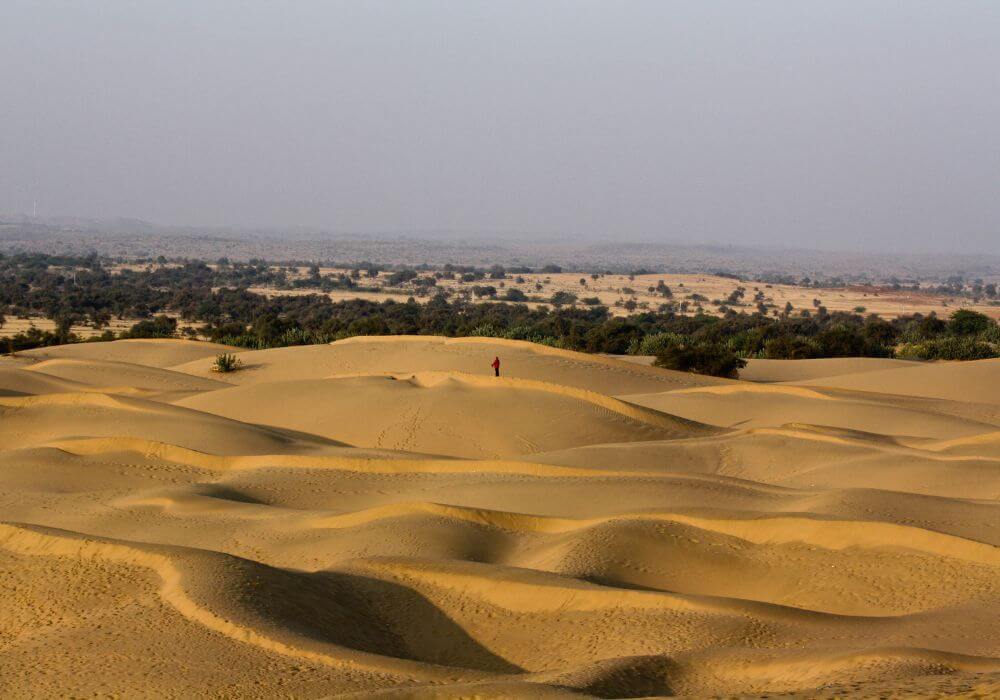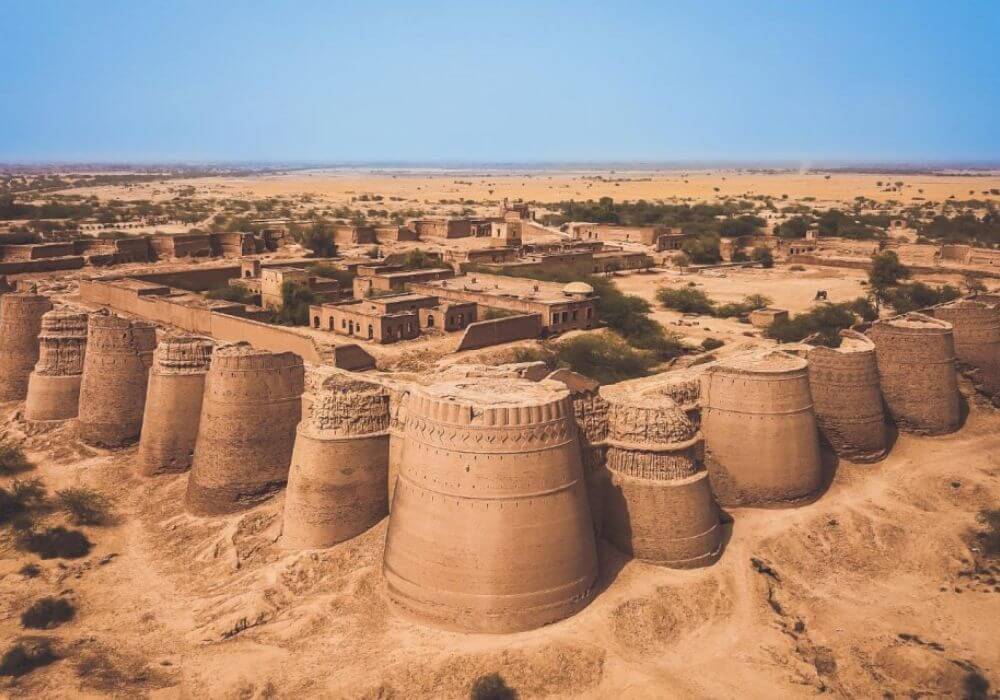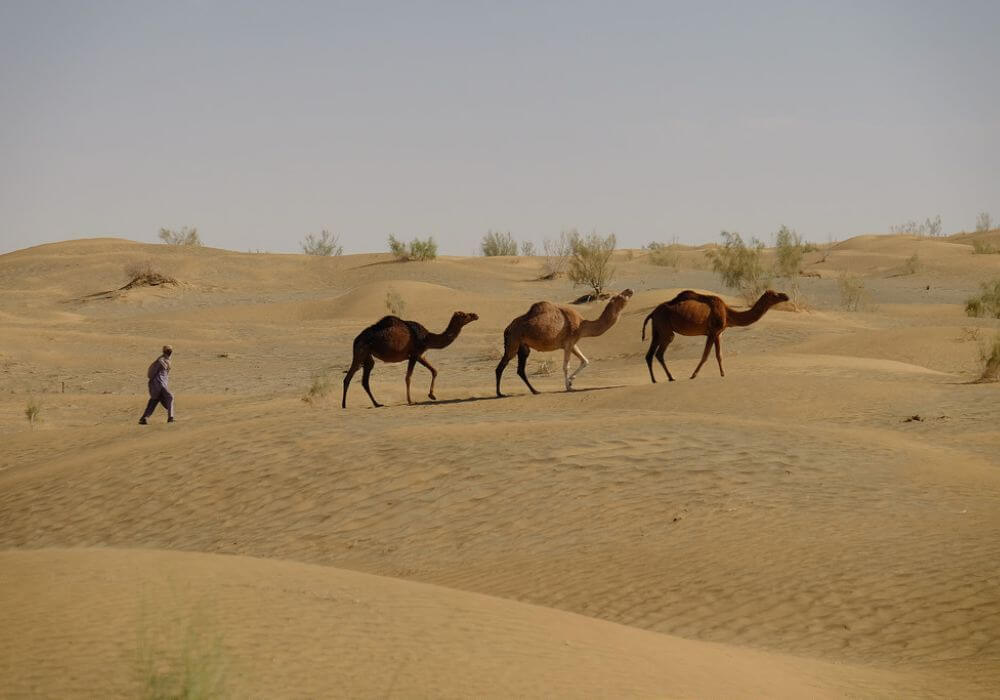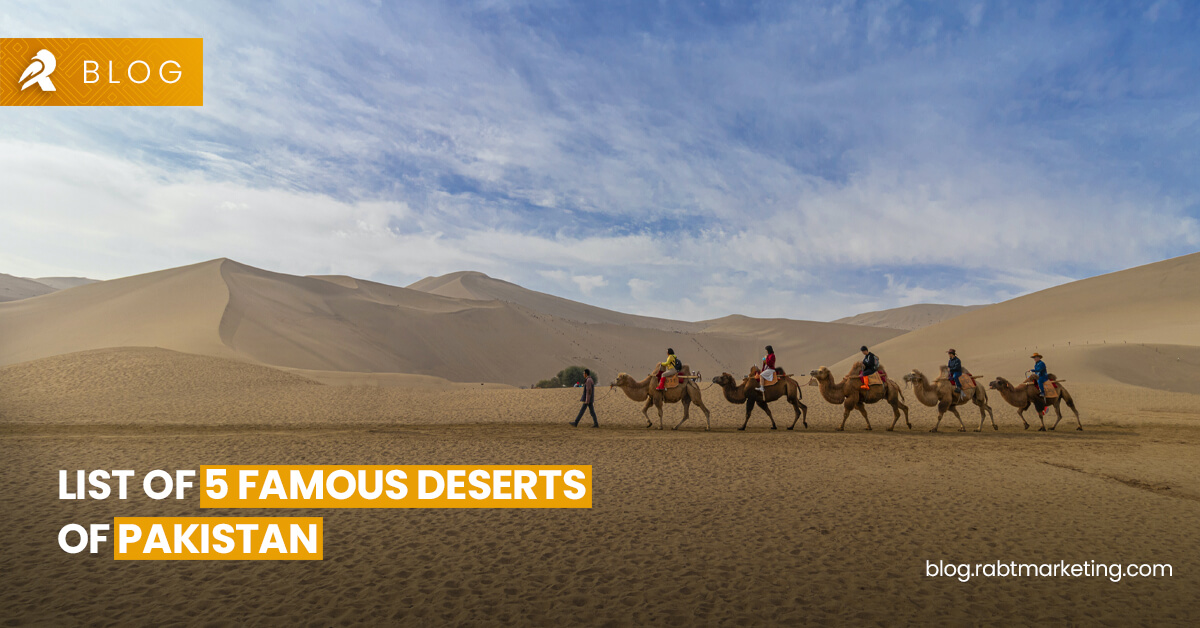Pakistan is known for its diverse geographical features, including its vast array of deserts. These deserts not only contribute to the country’s natural beauty but also hold immense significance in terms of culture, history, tourism, and ecological balance. Additionally, the desert regions have agricultural potential, with innovative irrigation techniques enabling the cultivation of crops such as wheat, cotton, and vegetables. The unique characteristics of these deserts, combined with their rich history, make them fascinating destinations for exploration and tourism.
Our country is home to five main deserts. These deserts include; the Thar Desert, Cholistan Desert, Kaptana Desert, Thal Desert, and Kharan Desert. Let’s discover these 5 famous deserts of Pakistan together!
Thar Desert

The Thar Desert is located in southeastern Pakistan and extends into northwestern India. Spread across an area of approximately 200,000 square kilometers, it stands as one of the largest deserts in the world. This desert area has extremely hot summers, extremely cold winters, and very little rain, which makes it a tough and challenging place to live.
People: The people who live in the desert are friendly and welcoming. They make visitors feel comfortable and at home. They wear colorful clothes, beautiful jewelry and perform lively folk music and dances, which make the desert even more enchanting.
Culture and Tradition: The Thar Desert is a special place filled with diverse cultures and traditions. Many different groups of people live there, such as the Rajputs, Bhils, and Jats. Each group has its own customs, art, and festivals, making the region rich in culture.
Plants: Contrary to what many people believe, the Thar Desert is not an empty and lifeless place. In fact, it’s a thriving ecosystem full of plants and animals. The desert has diverse plant life, including tough shrubs, cacti, thorny bushes, and different grasses.
Wildlife: The Thar Desert is also home to a wide variety of wildlife. You can see beautiful Indian gazelles and blackbucks moving across the sandy dunes. There are also secretive desert foxes and the powerful Indian wild ass, called the ghudkhar, which live in the desert. Bird enthusiasts can enjoy watching colorful migratory birds like the Demoiselle crane and the greater flamingo, which visit the desert during specific times of the year.
Also, Checkout to our this blog: Biggest Dams in Pakistan
Cholistan Desert

The Cholistan Desert, also called the Rohi Desert, is a large area of sandy land in southern Punjab. It is well-known for its unique culture, lively festivals, and traditional lifestyle. Spanning over 16,000 square kilometers, this desert holds a significant place in the region’s cultural heritage.
History: Cholistan Desert has a rich historical and cultural heritage dating back thousands of years. The region was once inhabited by the Indus Valley Civilization, and remnants of their existence can still be found in the form of archaeological sites and ancient artifacts.
Wildlife and flora: Despite its harsh environment, the Cholistan Desert is home to a diverse range of wildlife and flora. The desert supports a variety of animal species, such as the Indian gazelle, Chinkara, and desert fox. The flora of Cholistan consists of Prosopis cineraria, Haloxylon salicornicum, and Cenchrus ciliaris.
Forts and monuments: The Cholistan Desert is home to several historical forts and monuments. Derawar Fort is one of the most iconic structures in Cholistan. Other notable forts include the Jamgarh Fort, Islamgarh Fort, and Nawab Din Fort, each with its unique story.
Local Handicrafts: The Cholistan Desert is famous for its beautiful crafts, which show the region’s artistic history. Talented artists make detailed embroidery, mirrors on clothes, and products from camel leather that represent the colorful and unique designs of the desert. People who visit can go to local markets and see the craftsmen at work, and by buying their crafts, they can help the local economy.
Festivals: The area’s festivals include the jeep rally, the Cholistan desert festival, Bull Cart Race, Firework Night, etc. The Cholistan Jeep Rally showcases off-road motorsport skills, while the Cholistan Desert Festival promotes the region’s cultural heritage through camel races, music, dance, and handicraft exhibitions. These festivals offer a chance to immerse oneself in the desert’s unique culture, traditions, and natural beauty while enjoying a lively and celebratory atmosphere.
Katpana Desert

The Katpana Desert, one of the famous deserts of Pakistan, is located in the Skardu district of Gilgit-Baltistan. It is a cold desert situated at an altitude of approximately 2,226 meters (7,303 feet) above sea level. This remarkable desert stretches over an area of about 25 kilometers (15.5 miles) and is surrounded by towering mountains, including the world-famous Karakoram Range.
Unlike traditional deserts characterized by scorching heat, the Katpana Desert experiences extreme temperatures due to its high elevation. During winter, the desert transforms into a frosty wonderland, while summer brings moderate temperatures, making it an ideal destination for exploration.
Attractions: Skardu’s cold desert is a famous and beautiful place with lots of things to see and do. One of the most interesting spots there is the Katpana Desert. It has many attractions that will definitely make your visit worthwhile. This desert is well-known for its big sand hills, tall mountains called the Black Giants and stunning lake.
Climate: This desert is special because it has its own unique temperature and weather conditions. It is also known as the “Cold Desert” because it gets extremely cold there. The temperature in this desert can go as low as -5 degrees Celsius.
Things to do: Exploring the Katpana Cold Desert is a special experience that you can only have in Skardu Valley. You can go camping, stare at the stars, watch the sunset, or walk on the sand dunes. Many visitors enjoy listening to traditional stories and legends while sitting around a cozy bonfire. They also get to taste delicious trout and yak for dinner. You can also try motorbiking in the desert. This place is famous for hosting exciting Jeep Rally events every year.
Also, check our blog post: Top 13 Best Historical Places in Peshawar
Thal Desert

The Thal Desert is situated in the heart of Pakistan, covering parts of Punjab, Sindh, Khyber Pakhtunkhwa, and Balochistan provinces. It stretches over an area of approximately 19,000 square kilometers, making it the 3rd largest desert in the country. Its breathtaking landscape includes sand dunes, barren plains, and scattered vegetation. The Indus River bounds the desert to the east and the Sulaiman Range to the west.
Languages: In the region, the languages spoken include Urdu, Saraiki, and Balochi, which is a variant of Punjabi that has been developed and refined over time.
Climate: June is the desert’s warmest month, with an average temperature of approximately 34°C. The desert experiences extreme temperatures ranging from 0°C to as high as 44°C. On average, the desert receives about 277mm of rainfall per year. Moreover, the desert is renowned and attractive for rally racing.
Flore and fauna: Thal Desert supports diverse flora and fauna. The desert vegetation includes; Karir, Phog, Mesquite, Frash, etc. The Thal Desert is also home to several unique animal species, including the Indian Gazelle, Desert Monitor Lizard, and the Indian Bustard. These species have evolved remarkable adaptations to survive in the extreme desert environment.
Kharan Desert

The Kharan Desert, also known as the sandy desert, is located in the northeast part of Balochistan. It covers a large area of more than 20,000 square kilometers and is surrounded by an empty basin where no one lives. The desert has sandy dunes and hilly regions.
Historical significance: The Kharan desert became well-known because the Pakistani military carried out nuclear testing there. It became particularly famous when Pakistan conducted its second nuclear test, called Chagai-II, on May 30, 1998.
Landscape: The land is very dry and not suitable for growing crops because there is not much water for irrigation. The people who live there mainly make and sell cotton carpets that they stitch by hand. The landscape is mostly made up of dry, gray-brown sand that stretches over large areas.
Culture and tradition: The Kharan society is made up of different communities, but the Balochi culture is the most influential. People in Kharan value and enjoy their traditional folk music, dance, and stories. They also have specific food preferences, such as wheat, rice, millet, Saji, lassi, dates, lamb, and camel meat.
The traditional clothing worn by people in Kharan is a long and loose outfit called a shalwar-kurta. Women’s dresses are particularly known for the beautiful artwork of small mirrors and embroidery. Some parts of the region still have people living in houses made of mud.
Conclusion
Pakistan’s famous deserts offer a remarkable blend of natural beauty, cultural heritage, and adventurous experiences. From the golden sands of Cholistan to the captivating dunes of Thar, each desert has its unique charm and allure. Exploring these deserts provides an opportunity to appreciate the raw beauty of nature, immerse oneself in rich cultural traditions, and embark on thrilling adventures. The famous deserts of Pakistan are a testament to the country’s diverse landscapes and offer an unforgettable journey for those who seek to wander off the beaten path.

